

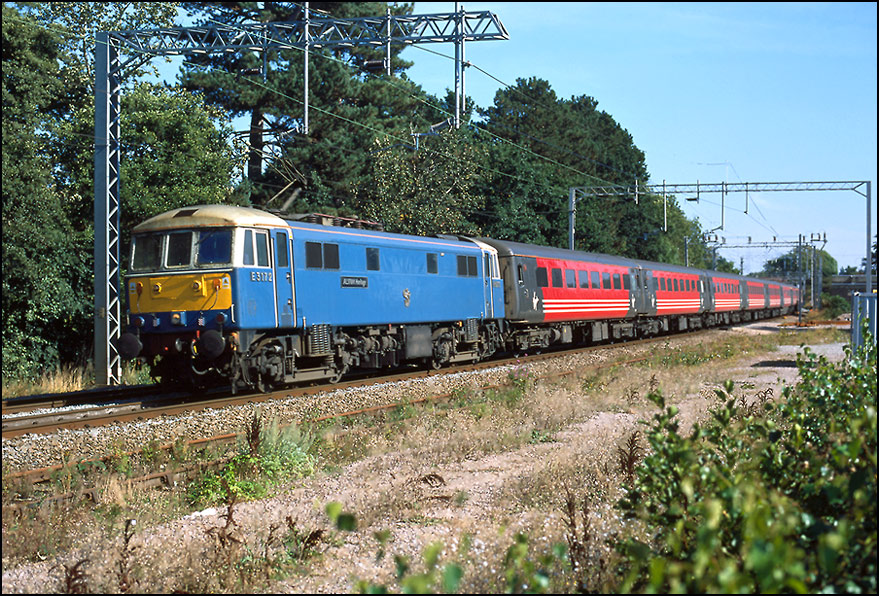
I must confess from the outset that I haven't taken as many photographs of electrically hauled trains as I perhaps should. It may be something to do with the lack of an exhaust sound, the fact that it is sometimes difficult to find locations where the catenary is not too obtrusive or just that they don't interest me quite as much as diesels. I haven't taken any pictures of slam door units in their final months, but do have quite a collection taken in the 1980s and 1990s in Hampshire and Kent. Towards the end of the classes 86 and 87 on passenger traffic I did make some effort to get a final record, but looking at my transparancies and a few digital images, it is all too clear that I took most of them from the station car park at Berkswell! This is only a 25 minute drive from my home and is thus the nearest electrified line. There will be quite a few shots from this location and I hope that the variety will make up for the somewhat tedious repetition. The truth is, I really couldn't be bothered to go further afield to the popular locations further south, which by all accounts, tended to become rather circus-like on sunny days. This really isn't my cup of tea, and as I'm relatively happy with the shots I took in earlier years, I didn't join the crowds. The same applies to the scene in 2020/21 when class 86s on container trains were stored. The line between Birmingham and Wolverhampton was one of my haunts in the late 1980s and I did enjoy my sessions along the stretch of line adjacent to the Birmingham Level canal around Dudley Port. The current electrical scene is one I don't see very often these, but I must admit to finding the Virgin Pendolino quite stylish and, in the right conditions, will happily take the occasional shot of one. Once again, I have found that the quality of some early shots is not as high as one would wish but hope once more that the archive interest will outweigh the technical shortcomings.
|
|
There was clearly a shot of Sarah Siddons from the sunny side in the Staff Car Park at Leamington Spa and here is a shot of her in the sole remaining siding. I will wager that this is the first time that a London Transport electric locomotive has been here and quite possibly the last time. There was no news about how it will be moved to Derby but it's difficult to see how road transport would be able to access the site so a low-speed drag seems likely. |
|
|
Towards the end of their use on WCML trains class some 87s were given different colour schemes including 87002 which in April 2004 carried this livery showing the then house colours of the Porterbrook leasing company. The train was passing Berkswell station with a Euston to Wolverhampton service. On 31 January 2008 the withdrawn locomotive was on its way to Long Marston along with 87028 and 87022 pictured passing Evesham signalbox behind 47805. While at Long Marston 87002 was repainted into Rail Blue as can be seen here at Honeybourne behind 66722 on 13 June 2008. |
|
|
Birmingham New Street was a gloomy place in 1990, especially after dark, but it was reasonably well lit and possible to take a decent picture using a long exposure. This shot of 85011 is dated 6 January 1990 with my camera resting on my aluminium case with settings of 10 seconds at f5.6 on medium format Kodak TRI-X 400asa. My notes are usually rubbish but for some reason I always wrote down exposure details when trying night photography. |
|
|
Class 323 EMUs were in the news during the second half of 2024 because of their impending withdrawal from services on the West Midlands' Cross-City Line. The most popular for photographers was 323221 because it was re-vinyled into a "retro" livery (probably called heritage in the way anything more than 10 years old seems to be these days) with the old Centro colours. This picture shows 323218 when this colour scheme was standard working a Wolverhampton to Coventry train just after leaving the station at Berkswell in April 2004. |
|
|
Looking the other way from the car park at Berkswell on 1 September 2004 I took this shot of 323215 running from Coventry to Wolverhampton. This was the time when the lineside growth was becoming a bit intrusive but it was still possible to use the bushes to create a frame for the picture, although it was necessary to stand on something to clear the nuisance bits. |
|
|
Tolworth station on the Chessington line has an attractive art-deco station which although offering no more shelter than modern structures is infinitely better designed and pleasing to the eye. I ws there on 30 March 1990 to photograph a class 33 hauling the Tolworth to Newhaven empty gravel hoppers. Before 33020 arrived light engine I took this shot of class 455 unit 5909 leaving the station on its way to Chessington. |
|
|
I had another trip to Tolworth on 3 May 1990 to try for another shot of the empty gravel hoppers going to Newhaven. As before a class 455, coincidentally 5909 again, came along from Waterloo and although the light was tricky took this shot. To make things worse the slide was badly under-exposed which shows all too well here. The empty hoppers didn't run despite them being in the small yard adjacent to the station. |
|
|
This image was taken on 3 May 1990 from some extensive waste ground between Bexley and Crayford and shows 2 4EPB units working from Dartford to Waterloo East. At this time there was a vast amount of freight along here, most of which was running in connection with the Channel Tunnel construction work. On this day I photographed 6 pairs of class 33, 2 class 56s and 3 class 47s as well as quite a few EPBs, all in sunshine. |
|
|
It's a long time since it was possible to see a third-rail electric locomotive hauling regular passenger trains, but this scene at Basingstoke was so commonplace as to be completely ignored by many photographers. It shows 73108 leaving Basingstoke on 1 April 1991 with 2 4TC sets while working a Southampton to London Waterloo service. A 4VEP is in Barton Mill Carriage Sidings and the Reading Road bridge, another good spot for photographing up trains, is just visible. |
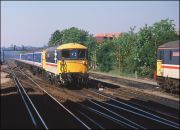 |
I was on my way to Kent from Basingstoke on 4 May 1990 when I saw 33008 preparing to leave the yard at Woking with a departmental trip for the London area. Naturally, I bailed out to photograph this, as it had just received the plain grey livery instead of the green it had previously carried. While waiting for this to come along, a very clean 73112 appeared on an up working to Waterloo from Weymouth and Southampton formed of 2 4TCs. |
|
|
This shot was taken on a very misty day sometime in the autumn of 1989 from the playing field at Winklebury on the outskirts of Basingstoke. It shows a 1939-built former 2 HAL (Half-Lavatory) unit in use as Unit 002 which I think was a Rail Head Treatment Train of some sort. I had no information other than that something was running to Eastleigh as an STP and was initially disappointed that it wasn't something with a class 33 on the front. The unit was far more interesting in retrospect but at the time I was pleased that a few minutes later a class 33/1 did appear hauling another RHTT unit, 004, which I think was built as a 2 (or curtailed) 4-SUB. |
|
|
Another photograph from Basingstoke but from the bypass bridge on the eastern side on 16 April 1991 and in much better weather. The leading units were not often seen here and were 2 SUBs 4321 + 4314 with what appear to be 2 4 car 4-VEPs The whole lot was running ECS and I assumed that they had come from Eastleigh and were going back towards the capital after maintenance work. |
|
|
I spent a few hours in the area around Kensington Olympia on 30 March 1990. This picture was taken from the road overlooking Earls Court and more importantly the LUL Depot at Lillie Bridge, the base for some battery locomotives used for p-way work when the current is switched off. There was quite a bit of movement going on and this is an unidentified locomotive moving out of the shed prior to forming a train. This viewpoint was a few yards along the road from the often-used spot overlooking the main line from where I took this image of 33058 working an Angerstein Wharf to Paddington New Yard stone train. |
|
|
These two battery locomotives at Lillie Bridge were easily identified as 23 and 31 after the sun had moved round on 30 March 1990. The train left the depot and I imagine that is was off to another yard on the system ready for some overnight work. |
|
|
I haven't had many sessions on 25 kv electrified lines but did go to the Northampton Loop of a few occasions such as 17 June 1994 with a visit to a bridge near Great Brington. This picture is of 86209 on the down line with an ECS working, origin and destination unknown. |
|
|
This was the view from the road bridge at Great Brington on 17 June 1994 with 86638 + 86639 working an intermodal train towards London. |
|
|
Class 304 units had a lot of character and in contrast to more modern trains were comfortable for passengers. This slide was taken on 22 October 1988 as 304043 was about to stop at Berkswell station with a Wolverhampton to Coventry all-stations local. The farmland in the right background has since become a commercial fishery with several lakes catering for anglers with various different interests ranging from match fishing to catching large carp. |
|
|
A very poor quality shot of 317325, one of just 2 I have of the class, taken at Berkswell on 22 October 1988 after the sun had all but disappeared. The train was a semi-fast to Watford Junction and was absolutely belting along under clear signals before it had to slow for the stop at Coventry. |
|
|
I don't often take platform edge shots but the light was so good on the frosty morning of 23 November 1988 that I shot everything that came along. This was 87034 with a London Euston to Wolverhampton express on the final leg of its journey along the Stour Valley line. The front end has clearly had a few impacts with something that was probably a bit heavier than a pigeon to have caused such a mess. |
|
|
The lowest numbered class 304 at the wooden platform of Tipton station on 23 November 1988 with a Coventry to Wolverhampton local service. It wasn't long before 304001 returned and here is the scene from the platform end, a popular spot with local photographers. The platforms have unsurprisingly been resurfaced with a less slippery material complete with the requisite yellow markings. |
|
|
I spent a few hours on a roadbridge near the Northamptonshire village of Great Brington on 17 June 1994 where there was a decent selection of electrics and diesel locomotives, mostly class 31s, to photograph. Among the regular stuff was an interloper in the form of 308157 which I suspect was working from the South-East Division of NSE to the Leeds area where they saw several years service. |
|
|
A more modern unit, 321413, was next along at Great Brington on 17 June 1994. In the absence of destination boards I have no idea where it was going but Birmingham and beyond would be a good bet. |
|
|
This was the view at Great Brington looking towards Rugby on 17 June 1994 as 310102 approached the bridge with a birmingham to London Euston semi-fast service. It looks as if there had been a landslip on the side of the cutting in the recent past with some stone used to provide access for road vehicles involved in fixing the problem. |
|
|
This is on of my two shots of a class 317 EMU. This one is from Bedford on 19 October 1985 as the driver entered the cab. HSTs have also disappeared from Bedford to St Pancras with class 22 units and more modern electrics doing the job in 2024. |
|
|
I spent a few hours at Gravesend on 26 October 1990 with the intention of photographing some 33s on Channel Tunnel traffic. This was achieved both in sun and some heavy rain and just before I left, EPB 5222 arrived in some nice backlighting on a terminating train from Charing Cross. |
_grvsend_261090.jpg) |
There was plenty of time at Gravesend on 26 October 1990 to go onto the platform as 4EPB 5222 waited to move out of the station before crossing over and reversing into the up platform for its journey to Charing Cross. |
|
|
As a Midlander, 3rd rail units were a bit of a novelty to me and the EPBs were a bit of a favourite. This is unit 5139 standing in the up platform at Gravesend about to pull forward for its reversal before returning to Charing Cross. |
|
|
My time at Gravesend on 26 October 1990 was raked by spells of sunshine and others of heavy rain. The previous good light had deteriorated to "black & white only" as 4EPB arrived from Charing Cross. The chalk cutting on the station approach can clearly be seen beyond the roadbridge. |
|
|
Completing my set of pictures from Gravesend on 26 October 1990 is this shot of 4EPB 5444 drawing into the up platform after reversing at the crossover on the other sode of the wide bridge in the background. |
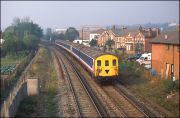 |
In the late 1980s and early 1990s I had a few outings to the line between West Byfleet and Staines with the intention of photographing the freightliner and departmental traffic, the latter of which was mostly in the hands of class 33s. As a Midlander, the third-rail units were of great interest to me and if the conditions were suitable I made a point of getting some record shots. Here is a 2HAP leading a 4VEP near Egham on a Waterloo to Ascot train on 27 September 1990. Neither of these classes will be found working trains in 2024 and in my opinion their replacements have nothing like as much character. |
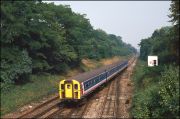 |
This picture shows 4VEP 3015 approaching the junction at Virginia Water on 24 August 1990 with what I noted at the time was a semi-fast to Reading. I'm not quite sure how I knew that - perhaps I had a SR headcode list I have since forgotten about. |
|
|
The car park at Berkswell station was popular with photographers in the early 2000s as it was very easy to get a decent shot in both directions. This image was taken in about September of that year and shows 87001, in between carrying the names Royal Scot and Stephenson, working a London Euston to, I think, Glasgow via Birmingham service. |
|
|
There aren't many shots of 25kv EMUs in my collection but I used to take the odd picture just for the record. This one shows 310081 on a Walsall to Birmingham New Street service as it paused at Bescot station on 23 May 1986. The composition isn't great and it seems likely that the sun came out just as the train was preparing to leave the station. |
|
|
An even worse quality image from Bescot from 23 May 1986 as the very strange-liveried 312204 also caught some weak sun at the wrong time. As far as can remember this unit was painted as part of a trial of the proposed livery WMPTE West Midlands Passenger Transport Executive) sponsored services. It was one of 4 Class 312/2 units built in 1976 specifically for services around Birmingham New Street often found on the New Street-International services. The phrase "bruised banana" comes to mind... |
|
|
There is no date on the mount of this medium format slide but I guess it was probably taken around 1989. It shows 312201 in Network South-East colours a bit off its intended area calling at Bescot with a Walsall to Birmingham New Street service. |
|
|
The Wolverhampton Level canal runs close to the railway and in 1989 there were plenty of good photographic locations including several in the Dudley Port area. This picture is of 87006 with the 11.25 Wolverhampton to Euston service on 14 January 1989 on a sunny day with the blue sky giving the canal a very different colour to its natural hue. The locomotive was one of those selscted for use in in Bulgaria and it is seen here at Lower Moor after leaving Long Marston after the work necessary before export. |
|
|
It seems a long time since several class 73s were used on the Basingstoke line passenger trains each day. This picture from Winchfield was taken on 4 January 1988 with 73110 leading a slightly unusual 3 car set plus the 5TC which was the usual 4TC with a buffer car added into the consist. The code 93 indicates that the train was an Eastleigh, Southampton, Bournemouth or Weymouth semi-fast service to London Waterloo. |
|
|
Another class 73, this time 73124, but with a Southampton to Eastleigh stopping service, code 93, about to call at Woking sometime in 1989. My notes don't mention this picture so I can't be more precise about the date but it seems to be the only picture I took here on that day, probably because it was so dull and with little else around. |
|
|
This picture is dated 30 September 1988 and of poor quality but just about worth reproducing as it shows Manchester to Sheffield 1500 DC line EM2 (class 77) 27000 and the preserved class 7 passing Leamington Spa with 33008 providing the power as the train was about to turn onto the Coventry line. The locomotives were returning from the Basingstoke Open Day and going to to Bescot for another exhibition. |
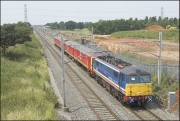 |
I'm not normally one for chasing around to get final workings of celebrity or retiring locomotives, but I had been thwarted in previous attempts to secure a photograph of 87012 since its repainting into NSE livery. This being the case I tried to find a location on 3 July 2006 to picture the well-publicised run of the locomotive with failed 325005 on the 5Z48 Polmadie to Wembley postal. I wanted to obtain my photograph in a location that would show the modern WCML and this spot, generally called Hanch, a few miles north of Lichfield, shows it well as it is the section of line that was undergoing heavy civil engineering work to convert it to 4 tracks. Note the Saltire crosses on the buffers and the sheet of paper on the 2nd man's windscreen saying, "Goodbye 87012". |
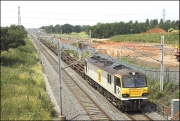 |
When I go to a new location it's always good to get a freight as well as a special working or timetabled passenger train. This shot shows 92034 with a loadless 4M41 Mossend to Daventry. This strange situation has been the norm since EWS lost this traffic to DRS and one must question the rationale behind running empty trains simply, I assume, to retain the path for the company. The location is again an overbridge at Hanch, a few miles north of Lichfield. |
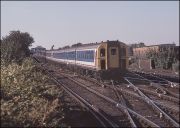 |
This pair of 4VEPs, 3187+3472, were working as empty stock when I photographed them coming down the bank from Nunhead towards Lewisham station on 28 August 1990. I was here to photograph 33042 + 33207 on the Battersea to Angerstein Wharf empty aggregate trains but could not resist photographing these units in the afternoon sun. |
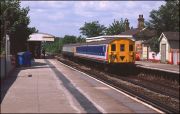 |
Another location I favoured was the station at Lee, just east of the sharp curve from Hither Green. On 25 May 1990 the station had not received too much of the bright red colour scheme of Network South East and still had concrete lamp posts and some attractive Southern Railway architecture. This was a good spot for photographing 33s on Channel Tunnel traffic and equally good for the then ubiquitous EPB stock. Here are contrasting units 6413+6260 standing in the down platform at 12.20 with a down service from Charing Cross to Dartford. The black triangle signifies that the guard's accomodation is at this end of the train. |
|
|
Another shot from Lee on 25 May 1990 shows blue & grey 4 EPB set 5464 leaving the station with another train heading east towards Dartford. |
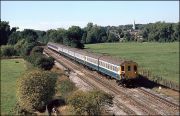 |
Earlier the same day upon which I took the photograph betweem Bexley and Crayford I spent some time on the A2 bridge between Bexley and Crayford, again with the aim of photographing 33s on some of the Channel Tunnel traffic. This was successfully accomplished as is shown in the Class 33 section, but I was also pleased to obtain some pictures of EPB stock on the Dartford runs, as seen here with 2EPB 6257 leading two 4 car sets and fittong nicely in the sunlit gap between the trees. |
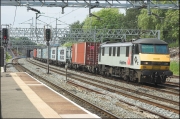 |
This image was taken at Tamworth Low Level station on 16 June 2006 on a day when there were several interesting workings to record. This one is the 4L75 Ditton to Ipswich hauled by 90042 about to pass through the station on the up fast line. I quite like station shots for electric trains as the overhead catenary tends not to be so intrusive as some other locations. |
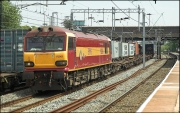 |
Just as 90042 as shown above was heading east on the up line at Tamworth on 16 June 2006 EWS liveried 92001 was going west with the 4S62 to Mossend. I don't get onto electrified lines all that often, which probably explains why this is the first photograph I had taken of a red class 92. In retrospect, the passing shot with 4L75 wasn't too bad as there were some empty flats behind the 92 and it does have a certain attraction as it does show some real railway action. |
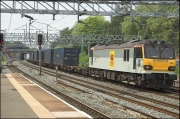 |
The next train to appear from the west should have been 4L46, but this was reported as being some 30 minutes late , so the 4M41 05:35 Mossend-Daventry behind 92005 showed up first. Carrying EWS stickers, the 92 heads its train towards its destination on the up fast line and I very nearly managed to mess up the image by taking it bit too late on my first digital camera which had no fast multiple exposure facility. |
|
|
On my way home from Tamworth on 16 June 2006 I made the short diversion to Berkswell station to take a few shots including this of 92007 working 6A42, the 15.14 Bescot to Wembley ferrywagons. As usual, this was a long train and locations to fit the whole thing into a picture are few and far between. |
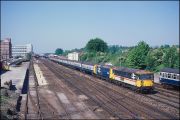 |
This picture taken from the Reading Road bridge to the East of Basingstoke station. It shows 73136 + 73114 on the second day of the 1988 summer timetable, 17 May, leaving the station with a Southampton to Waterloo train. Out of the 24 class 442s ordered, only 5 had been delivered so interim arrangements had to be made and these included the use of pairs of 73s on Bournemouth and Southampton services with a variety of stock. Note that the 4TC behind the locos has had a buffet car inserted to provide refreshment facilities. 645 |
|
|
Although only 5 class 442 sets had been delivered for the start of the 1988 summer timetable it was not hard to work out that photographs of those in service would be possible at Basingstoke! Here are 2 units on a morning Southampton to Waterloo service leaving the station and about to pass under the Reading Road bridge. These were excepionally comfortable and quiet trains and on the occasions I travelled from Basingstoke to London I invariably chose to travel on a 442 in preference to a class 50 hauled set. |
|
|
In addition to the new class 442s shown above there was an arguably more interesting train at Basingstoke on 17 May 1988 and it was news of this running from a local driver that led me to go out on the second day of the new timetable rather than the first. Two class 415 (2-EPB) NSE Rail Cleaning units, 015 + 016, were sandwiching a High Speed Track Recording Unit coach on a diagram from Clapham Yard and back. Here is the train slowing for its stop at Basingstoke with unit unit 015 trailing the formation as it was overtaken by a pair of class 73/1s with a 5TC unit on a down Southampton train. |
|
|
There was plenty of time on 15 May 1988 for a trip from Basingstoke to Winchfield in order to have another shot of the NSE rail cleaning units 016 + 015 being used to power the HSTRU. It was booked on the slow lines and the best photo in the early afternoon was clearly going to be as it receded from the camera and passed through the station. |
|
|
Old and new EMUs at Basingstoke on 17 May 1988 as 2 class 442 units go into the station with a Waterloo to Southampton train and 4VEP 3125 leave on the up slow lines with an all stations local service to London. |
|
|
In 1987 most of the local trains between Wolverhampton, Birmingham New Street and Walsall were operated with class 304 units, often referred to as "Dinosaurs". In this picture from New Street on 24 September 1987 unit 015 had just arrived from Wolverhampton and was preparing to return along the Stour Valley Line. These units had a comfortable ride largely because of their Gresley-designed bogies and very well padded seats. 645 |
|
|
By 1989 withdrawal of class 304 EMUs was in progress with replacements in the form of class 310 appearing more frequently. This is the first of 2 pictures of 304009 I took near the Soho EMU depot on 1 April 1989 as the train as working an afternoon Walsall to Wolverhampton service. This was a great location at the time but I'm sure that the undergrowth has taken over and the slightly dodgy wooden fence allowing access will have been replaced with something spiky and more secure. 645 |
|
|
This is the view looking towards Wolverhampton from the same spot near the Dudley Road as the picture above. Soho EMU is visible on the left and there is a real mixture of bland modern and earlier red brick architecture in the surrounding area. |
|
|
Berkswell station car park was a convenient spot for photography in 2003, especially at weekends when there were fewer cars parked alongside the fence. I expect that the bushes have taken over here by 2021 and so the location has been lost. This picture shows 90005 heading towards Birmingham with an early afternoon train from London Euston to Wolverhampton on 15 March 2003 and the shadows of 3 other photographers can be seen in the foreground. 645 |
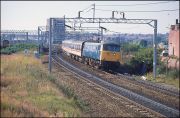 |
In contrast to Berkswell I never saw another photographer here, possibly because it accessible only by scrambling through a small gap in a wooden fence and the access probably not entirely legitimate. The location is just to the east of the Soho junctions and adjacent to the EMU depot and I imagine that through a combination of undergrwoth and spikey fencing it is no longer a viable spot for photography.In this shot 85037 is seen on the up line during the late morning of 15 July 1989 with a Liverpool to Euston train.645 |
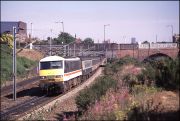 |
This is the view turning around from the shot above. The class 90 is 90006 in original condition heading the 16.44 Birmingham New Street to Liverpool Lime Street on 15 July 1989. This scene was nicely enhanced by the abundance of plant life including Rosebay Willowherb (Angustifolium Epilobium) so commonplace on railway cuttings and enbankments all over the country. 645 |
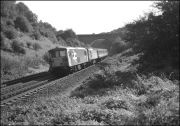 |
This picture is one few I have of a class 73 away the third rail and shows 73002 + 33116 in Harbury Cutting, near Leamington Spa, on 11 October 1987 with a 1Z47 0900 Waterloo to Kidderminster charter. The use of a class 73/0 away from the juice for such a long trip was unusual to say the least and simply had to recorded on film. As is obvious, this was a sunny morning and a colour shot as well as this one would have been nice given the rarity of the working. Unfortunately, the cable release meant to be operating my Olympus OM1n on a frame with my Mamiya failed at the crucial moment. |
|
|
This and some of the following few shots show some LUL traffic around Neasden Depot in London taken on 8 March 1991. My knowledge of this sort of stock was shamefully lacking but I now have a lot more information from James Sutcliife so my thanks to James. This image shows 1983 stock built for the Jubilee Line. The trains were not a huge success and one of their problems was the single leaf doors which meant it was a slow process boarding during peak hours. They also had various electrical faults and all were gone by 1998 with the majority scrapped. A few cars survive in non-railway use |
|
|
I at least know that the destination of this LUL train passing Neasden Depot on 8 March 1991 was Aldgate, this being clearly visible on the highj resolution scan of the original Fujichrome slide. This is a train of the much more successful A60 and A62 stock built by Cravens of Sheffield in the early 1960s. They were withdrawn in 2012. As they were used on long journeys of over an hour they had transverse seating, luggage racks and even umbrella hooks! This was to reflect the fact they served the upmarkert areas of the Metropolitan Line, including Amersham, Chesham and Rickmansworth. I find the infrastructure and operation of the overground LUL traffic quite engaging and wish that I done more photography with it around this time when the older units were still extant. |
|
|
This picture from Neasden Depot on 8 March 1991 didn't work out quite as well as I might have hoped. I didn't really want the unit passing by on the main line in shot but in retrospect it adds a little interest to the view of a different class leaving the depot. |
|
|
A slightly shadowy view of an LUL unit passing between Neasden Depot and the BR, as it was then, line between Amersham and Marylebone. I took a lot of pictures during the 4 or so hours I was on the bridge alongside the North Circular on 8 March 1991 and have tried to pick a variety for this section but as I mentioned above have no knowledge of what I was shooting. |
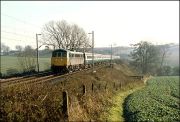 |
I had a couple of photographic outings to Weedon on the WCML in 1984 and 1985. From the first session is this picture of 86261 heading south out of Stowe Hill tunnel on 28 December 1984. I had been to visit some family in the area but clearly found the attraction of a sunny morning by the railway a better bet than being stuck indoors for another day! |
|
|
The shot looking othe other way from the view above isn't quite so photogenic particularly in the afternoon when the sun is getting a bit low in the sky. There was, though, a patch of line clear of shadows so I took this image of 86242 largely because the InterCity colour scheme was relatively new at that time. |
|
|
An unidentified class 86 was photographed from the side of a rural lane neat Weedon on 28 December 1984. I can't imagine that the growth of vegeation here would allow a repeat shot in 2021 but as there is virtually no traffic of any interest to me on this part of the WCML, most freight being routed through Northampton, I don't think I shall be going for a look. |
|
|
My final photograph at Weedon on 28 December 1984 was just before the shadows became too long and as a sharp frost began to settle on the lineside grass. The train is an unidentified express headed by 86254 and shows how relatively open the countryside was in 1984; I very much doubt such a shot is possible in 2021. |
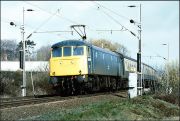 |
My second trip to Weedon was on 6 April 1985 and I started chatting to a permanent way gang who invited me to join them on their access road; a perfectly safe location but not usually available to the general public. This picture taken with a 135mm lens shows 85007 on the 07.40 Manchester Piccadilly to London Euston as it ran around the curves which had a speed limit of 80mph in both directions. |
|
|
Taken from the same access road as the shot above this one but with a shorter lens shows 87016 heading towards London Euston with the 06.30 from Carlisle. |
|
|
I had more interest in Southern Region electric units than 25kv AC electric locomotives and as a result of many days spent seeking out class 33s accumulated a lot of slides and negatives of various classes. On 25 May 1990 I was at Belvedere station waiting for an aggregate train from Angerstein Wharf and took this picture of 2 4Subs led by unit 5615. I used a 200mm lens to bring up the architectural variety beyond Abbey Wood station which can just be seen beyond the roadbridge. |
|
|
This is the view from the footbridge at Belvedere station with a 50mm lens as 2EPB 6256 leads 6 other cars of simuilar 4 and 2 car units on a Charing Cross to Gillingham service. |
|
|
An 8 car train of EPB stock led by unit 6231 has just stopped at Charlton station on 2 May 1990 with a down Charing Cross service. There was an intensive passenger service along this line between which a few freights had to be pathed. On this occasion one of the brief gaps in traffic was filled by 33058 + 33004 heading an Angerstein Wharf to Park Royal aggregates train. |
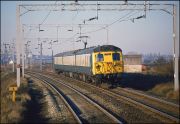 |
I had a bit of soft spot for the class 304 "Dinosaur" units used around Birmingham. This picture shows 304001 approaching Tipton station on the morning of 23 November 1988 with one of the 1/2 hourly Wolverhampton to Walsall trains. These units ran on bogies designed by Sir Nigel Gresley and their riding qualities were second to none. This location at the end of Tipton's down platform was quite a favourite with photogaphers at the time along with some of the canalside shots a bit further along the line. 645 |
|
|
There were many decent photographic locations to be found by having a walk along the towpath of the Birmingham to Wolverhampton canal and with regular locomotive hauled passenger trains there were plenty of subjects. This shot was taken on the morning of 4 January 1989 and shows 86231 working the morning London Paddington to Manchester Piccadilly train. The canal had been partially drained to allow for maintenance and later in the day I spent a while watching a large common carp swimming along - quite an unexpected sight in the middle of winter when such fish are largely dormant and holed up somewhere secure. 645 |
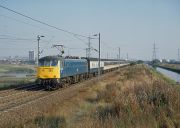 |
Staying in the West Midlands, this picture shows another class 85, 85028 on 1G32 Euston to Wolverhampton on 30 September 1989. The location is the canal junction near Dudley Port, an area which I regularly visited at the time as it offered plenty of trains and a good variety of shots. The locomotive has clearly had a minor collision which was not considered to be worth repairing bearing in mind that the class was not long for this world. 645 |
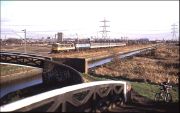 |
Here is another photograph at Dudley Port, this time of 86407 on another Euston to Wolverhampton on 14 January 1989. The bridge on which I am standing runs over the branch of the Wolverhampton canal going to Kingswinford. 645 |
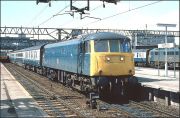 |
A Liverpool to Euston express is seen here at Stafford on 14 June 1985 which would have travelled via the Independent Lines at Crewe as the main lines through the station were not available because of the major remodelling work being carried out at that time. The locomotive is 81019 with a class 86 in the background and a class 310 unit in the platform adjacent to the 81. |
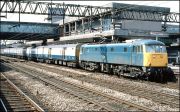 |
This picture was taken on 15 June 1985 and shows 85030 arriving at Stafford with an up Travelling Post Office train. In retrospect, the corporate blue and grey livery was a bit on the dull side and it is strange any locomotive in what some call a "heritage" livery are keenly sought. |
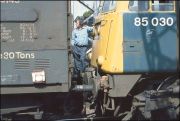 |
This is a close-up of the train shown above after another van was shunted into the consist. The shunting was a bit over-enthusiastic as the locked buffers show and took quite a long time for this to be resolved meaning that the train left some 40 minutes late. |
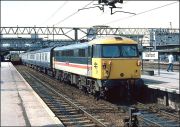 |
A final shot at Stafford on 14 June 1985 depicts 87019 carrying its fairly new Intercity livery. There were more locomotives than matching rakes of stock at this time so it was quite usual to see scenes like this around this time. |
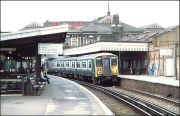 |
This photograph from Clapham Junction shows 5708 on a Waterloo to Dorking working on 24 August 1985. This was my first visit to this station since 1963 when I spent a two week holiday with an Aunt and Uncle in London. My cousin was a dedicated enthusiast and it was his influence that launched me into the world of train spotting. The main difference between 1985 and 2005 is the enormously colourful scene of the modern railway. The only splash of colour in 1985 was an Intercity-liveried class 73 on Victoria to Gatwick trains. This will appear below. |
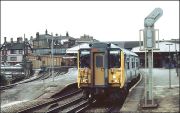 |
Here is another of the same class, but this time on an ECS working from Waterloo. I've included this picture largely because of the incongruity of the mock Tudor half-timbered pub in the background. Is is still there, I wonder? |
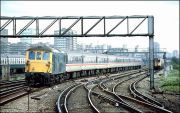 |
Class 73s have been a feature of the scene at Clapham Junction for many years and indeed still appear on rare occasions in late 2005. Here is a plain blue 73125 on the circuit on 24 August 1985 with a mis-matching Intercity rake of coaches approaching Clapham Junction from Victoria. |
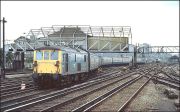 |
Another blue 73, this time 73113, is seen here at Clapham Junction shunting a rake of stock. I recall the locomotive using it's diesel engine for this move. The signal box must have been a frantically busy place in which to work, and the structure of it is of great interest. The framework across the roof dates from World War II when armoured plating was placed across it for protection from enemy action. The weight of the plating was later found to have caused the structure to sag, and it was therefore removed. |
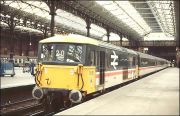 |
Moving into Victoria station itself, here is 73102 newly repainted and named Airtourre Suisse. I seem to recall that this was the first of the class to carry the brighter colours and the whole train certainly stood out well compared to those in the corporate blue & grey. |
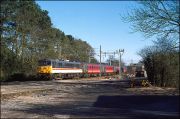 |
Another shot taken in the same place and on the same day as the one above was this of InterCity liveried 86228 on 1G29, the 13.00 Euston to Wolverhampton. 645 |
|
|
Four later 86228 had been withdrawn from traffic and was in store at Long Marston. Surprisingly, its nameplates were still attached although those on the other locomotives in the line had been removed. It was one of the pool that was repainted into the black Floyd livery and exported to Hungary. I don't have a picture of it in these colours but here is another, 86218 with 47727 waiting to enter Long Marston. |
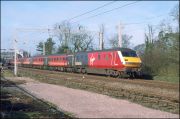 |
If my experience is typical, then relatively few people photograph the DVT end of WCML sets but I believe in trying to get a record of all aspects and not just locomotives. Here is 82213 and its train being propelled by 89245 through Berkswell on 11 February 2003. |
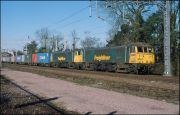 |
The Trent Valley line was closed on 11 February 2003 and several freights were diverted along the Stechford to Rugby line. One of these was 4L08 Trafford Park to Ipswich which is seen here behind 86620+86627. The shadows of a couple of other photographers can be seen in the foreground; rather unkindly, the assorted mass was later referred to by someone who wasn't there as the "Berkswell Veg"!. On a day with such perfect light it is hardly surprising that a few people were out to take advantage of the extra traffic. |
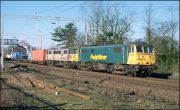 |
Another pair of 86s appeared a short time later on another freightliner. This time, it was 86609+86633 with the 4L97 Trafford Park to Felixstowe. |
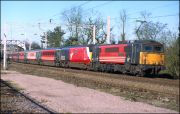 |
It was not just freight that was diverted on 11 February 2003. Passenger services to and from Euston also came through Berkswell and this is 87025 with DVT 82212 hauling the 1M08 Glasgow to Euston. |
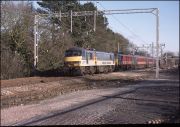 |
One of the last shots of 11 February 2003 resulted in this image of Railfreight Distribution 90033 hauling 86205 on an afternoon Euston to Wolverhampton train. This shot was taken at about 15.15 and the shadows were beginning to encroach on the scene. |
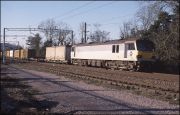 |
Just after 90033 had passed, 92039 came from the Birmingham direction with this up intermodal. I wasn't able to ascertain the identity of this train but think it may have been a Trafford Park to Wembley working. |
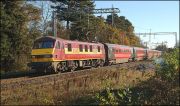 |
Here is a digital image of EWS 90031 on a Euston to Birmingham train passing the car park at Berkswell on 13 November 2004. Pendolini had taken over a lot of services by this time, so the remaining loco-hauled services become much more eagerly sought by some enthusiasts. The line in the foreground is very occasionally used for stabling track machines, but in earlier times was the start of the branch to Kenilworth Junction. |
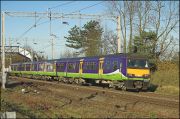 |
The local traffic on the Coventry line is also of interest and on 13 November 2004 Silverlink's 321418 was in use as a stopping train between Birmingham New Street and Coventry, from where it regained its semi-fast status to Euston. It is seen here leaving the Berkswell stop. |
|
|
Here is another shot of 321418 this time in Network South East colours and paired with another class member in Silverlink livery on 15 March 2003. The location is similar and they are on the same sort of working, a Birmingham to London Euston stopper. |
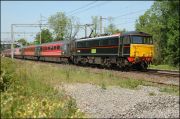 |
Towards the end regular class 87 workings on the Euston to Birmingham/Wolverhampton corridor, 3 of the class were repainted. My favourite was 87019 which received LNWR black. I think this colour suited the locomotive really well, especially when clean. It is seen here propelling its train towards Birmingham. I'm no great fan of the going-away shot and it is sometimes difficult to position the locomotive correctly. I was lucky this time........ |
|
|
Another pair of well-matched class 86s is seen here passing Berkswell station on 15 March 2003 with a diverted train heading towards I don't know where. Without a STN it wasn't easy to identify some of these workings and I can't say that I am really interested with it being so long ago! |
|
|
The final shot in this slightly repetitive selection of images from Berkswell is this of 90025 unusually propelling a down train from London Euston to Birmingham New Street. The little used loop in the foreground was part ofthe branch line to Kenilworth but was by this time only saw occasional stabling of OTP. |
|
|
My one and only trip to Liverpool took place on Saturday 24 July 1990. The main reason for the visit was to take some pictures of class 20s on some coal movements to and from the docks but there was plenty of time between the empty wagons going into the docks and loaded leaving so some time was spent taking pictures of the class 507 and 508 thir drail electric units operating the Metro services. Here, with Bank Hall station in the background, is 507102 passing Sandhills Junction. |
|
|
My second shot on the Liverpool Metro shows another class 507 shortly after leaving Kirkdale station and passing Kirkdale EMU depot. |
|
|
This image shows two class 508s with 508140 leading at Bank Hall station on 24 July 1990. This scene id fairly typical of the post-industrial landscape of many British cities where the attractive Victorian architecture is being replaced by ugly utilitarian building where the cost of construction is the only criterion. |
|
|
There is still some attractive industrial architecture in the scene although the original road bridge has clearly been rebuilt probably to cater for a much wider road than the original. I can't recall the exact location but it can't be too far from the Bank Hall area as I didn't go far away from the freight line area so as to be on hand when the coal train appeared. |
|
|
After photographing 20141+20013 returning through the yard shown in the link to the first image in this sequence a move was made to the bridge beyond Bank Hall station. The heavy coal train stalled on the climb up to the Edge Hill freight line and despite several noisy and smoky attempts the driver had no joy in moving it. After a delay of about 2 hours another pair of 20s were sent from Edge Hill depot just as two 3 coach class 507s went by on the electrified line. The resce locomotives soon coupled to the stalled train and the quadruple-header erupted into life and with a great deal of noise moved the train past the camera just before the light died altogether. |
|
|
One of my favourite EMUs was the EPB (Electro-Pneumatic Brake. These ran all over the former South East division although my main contact with them was on the line from Charing Cross to Dartford via the Sidcup loop on my trips to photograph class 33s on various aggregate and departmental workings. On 28 September 1990 I had an excellent day out on the line which finished off at Lewisham with the intention of photographing 33042+33207 on the Battersea to Angerstein Wharf empty aggregate train. While waiting for this I amused myself my taking several pictures of the units including this of an 8 car NSE and blue/grey combo on a Charing Cross to Dartford service as it approached the station. |
|
|
There was never more than a few minutes to wait before another EPB set or two came towards Lewisham station and here is an 8 car led by 5154. These units were quite fun on which to travel; their bouncing ride over jointed track with many junctions was compensated for by thickly padded and moquette-covered seats. They also had sliding windows which in some ways were preferable to the hermetically sealed version in modern trains; at least there was some local control over temperature in the carriage. |
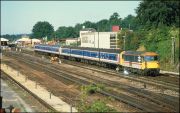 |
This was the view from the Reading Road, or Norn Hill, in Basingstoke on 14 August 1989 showing 73112 striking a spark with a morning Waterloo service formed of TC sets 8018+8028. I had earlier seen a couple of units spark on the same spot but was especially pleased to get a 73 doing the same. I haven't been to this location since 1991 and I imagine that it has probably seem some changes in the intervening years. |
|
|
A couple of miles to the west of Basingstoke is the well-known location of Battledown where the Southampton and Exeter lines diverge at Worting Junction. I was a bit surprised to have spent the afternoon of 31 December 1990 on my own here as most of the Exeter and Salisbury trains were class 33 hauled as the usual class 50s were mostly unavailable. This colourful train was an unexpected bonus with 73005 was pictured dragging a failed class 205 3H unit to Eastleigh for repair. |
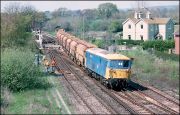 |
On 28 April 1989 I had a trip to the Chichester area with the intention of photographing the gravel train which made several trips between Drayton and the loading terminal at Lavant on the former branch to Midhurst. 73004 was in charge and this shot sees the train leaving the branch at Fishbourne Junction. The wagons used on this run were unique and were loaded from the top via a hopper filled by conveyor belt from the extraction point some distance away, and discharged from the sides. The details of the wagons, as kindly supplied by John Manchester are as follows :- JGA Bogie Hopper wagons - FR17001 to FR17011 Design Code JG003A. (Previously PHA - Design code PH003A). Built by IMC Engineering at Hartlepool 1971-1972. (The FR stands for Frances Parker Limited). |
|
|
This heavily backlit picture taken on 28 April 1989 shows 73004 passing the yard at Chichester with its train of empty JGAs on the way back to Lavant for another load of gravel. This wasn't a great location for a westbound train but I did want to include the semaphore signals, albeit only the top of post, and the yard itself which was still in regular use for CCE materials at that time. |
|
|
My next picture was of another train of empties that had just passed through Chichester station and shows the signalbox to reasonable effect. This was one of a just a handful for which the sun wasn't out but given the unique and unrepeatable nature of the image I wasn't and am still not remotely concerned. |
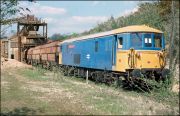 |
The third photograph in this short section shows 73004 with its train under the loader at Lavant. It was strange that an electro-diesel was digrammed for this working as none of the lines upon which the train ran was electrified; and I remember feeling a little disappointed at the time that a class 33 wasn't diagrammed on this particular day. Time has changed my mind and in retrospect a class 73/0 and especially this one was a far more attractive proposition. I did find out later that the train was almnost exclusively powered by class 73s with only the very occasional appearance from a class 33. |
_28489.jpg) |
The next shot shows 73004 leaving the terminal and heading for the unloading location at Drayton. I remember the shot being slightly awkward for some reason and have had to crop the hi-res TIFF image taken from the original slide to make it look reasonably well balanced. There were in the region of 5 trips a day until 1991 when all traffic ceased. The track itself was lifted in about 1992, and the trackbed converted to a cycleway. The wagons were parked at the old processing plant at Drayton for a year or so until they were all broken up on site and so became extinct. |
|
|
Photographic opportunities on the former Midhurst branch to Lavant were sparse to say the least and this bridge at the end of the conveniently placed run-round was about it. As is obvious, the branch was in a heavily wooded spot but at least the train was visible on 28 April 1989 which may not have been the case a few weeks later when the foliage was fully established. The loaded train headed by 73004 has just left the Lavant loading point as is heading for Fishbourne Junction and the main line through Chichester to the unloading yard at Drayton. Note the ancient "Stop" Board and the equally venerable telegraph post from the early days of the line. |
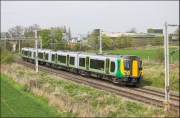 |
After a dull start, the weather on Tuesday 14 April 2009 looked as if might brighten up after lunch so I had a trip across to the Birmingham to Coventry line. There is virtually no freight along here these days but there are plenty of passenger trains about and it is good to keep one's collection of these up to date. First to appear by the occupation bridge at Wootton Green, near Balsall Common, in a patch of half sun was Desiro 350121 on a local train to Coventry. These are one of the very few trains upon which I have travelled and, in my opinion, and very comfortable and fast and give a much better ride than some units, such as Voyagers, designed for long distance travel. |
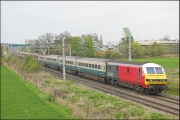 |
One of Virgin West Coast's Pendolinos is currently out of service following a shunting accident and a locomotive hauled substitute set is operating a few Birmingham New Street to Euston trains. The subject of this picture is 1B50, the 14.00 to Euston being driven from DVT 82101, still in the remnants of its Virgin colour scheme, and propelled by 90036 wearing the livery of its former owner, EWS. I don't get especially fired up by any electric traction, probably as a result of developing my interest in railways miles away from any electrified lines, but I do quite like the contrast of the various different paint jobs carried by this train, including 4 Cargo-D Mk3s, as it passed Wootton Green, near Balsall Common, on 14 April 2009. |
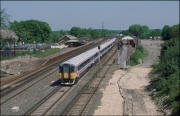 |
At the beginning of 2007, the class 442 Wessex units are destined for storage. They have lived pretty much out of the limelight for most of their 19 years in front line service but now, of course, every turn of a wheel is reported. These were possibly the most comfortable trains in which I have travelled; I was a regular passenger on the 09.20 Basingstoke to Waterloo between 1987 and 1991 and almost exclusively chose a 442 over the following class 50-hauled service because of the superior acceleration, much more comfortable seats and air conditioning. Here is a pair of anonymous units passing Winchfield with a Waterloo to Weymouth train, not long after the units' introduction, on 17 May 1988. |
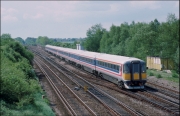 |
I imagine that over the past few weeks a lot of photographs of class 442s has been taken from this bridge near Worting Junction, Basingstoke. This was the scene on 19 May 1988 as a pair of units raced off Battledown flyover and on towards Basingstoke. I consider that the original livery suited these trains much better than the later and more garish versions, and always preferred to see the panels covering the connectors in place as it gave a much sleeker and more streamlined appearance. |
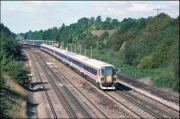 |
This was one of my favourite spots around Basingstoke for up trains in the mornings. There was usually quite a variety of traffic, with 33s and 50s on passenger trains from Exeter and Salisbury, a class 47 on a freightliner, a 56 on a stone train to Woking and of course a selection of EMUs. Here is a pair of class 442s on the 09.20 departure for Waterloo passing a triplet of 2 car units and some other EMUs in Barton Mill carriage sidings. |
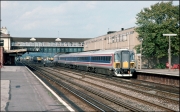 |
Moving down to Eastleigh, this picture shows a single 5 car Wessex units making its booked stop in the station as a sister unit departs into the distance. 33106 is about to pass through on the Waterloo to Bournemouth vans and representatives of class 08, class 37 and 47 can just be glimpsed in the background. Unit 5419 from the South Eastern division is also waiting to come through the station - this went round the curve to the works where it was destined for some attention. |
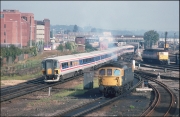 |
Another picture from Eastleigh, this time from the bridge on the west side of the station, shows a pair of class 442s leaving the platform road while 33109 smokes away as it waits for the the unidentified class 47 to clear the road before it can enter the yard. |
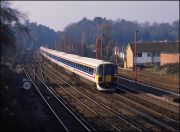 |
The class 442 Wessex units were introduced in 1988 and brought unprecedented levels of comfort and speed to the LSWR. The ride was exceptionally smooth on the well-maintained tracks and, with their traction motors recycled from REPs, had excellent acceleration. Here are units 2420+2417 approaching the Woking stop on 23 February 1990 while a 4VEP on the up slow is overtaken. I didn't like to see these otherwise stylish units without their coupling covers; it really spoiled the sleek lines. The lamp posts intended to illuminate the sidings had only just been painted NSE red and do not exactly help the ambience of the scene. |
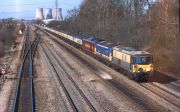 |
This shot shows an even rarer combination of 73108_73109+60004 on Pathfinder's "Weaving Weasel" railtour, 1Z42 Sheffield to Eastleigh on 26 February 2000. The colourful train is seen in Moreton Cutting shortly after leaving Didcot. |
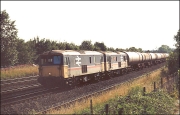 |
This picture of 73101+73134 was taken on the evening of 2 August 1991 from the playing field at Winklebury, in the western outskirts of Basingstoke. I'm not entirely sure of the train's identity as I've mislaid the WTT from that period but I think it ran from Southampton to somewhere in the London area. |
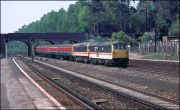 |
The second station to the east of Basingstoke is Winchfield and the station area here offers the chance for decent photographs with a recognisable background. This picture, taken from the down platform on 1 May 1990 shows 73205 and 83301 (formerly 33115) with a test train formed from a TC unit. The train was testing bogies fitted to the class 33, which were proposed for channel tunnel work. This was the first day of testing and several runs were made between Basingstoke and Woking. Incidentally, doesn't the InterCity colour scheme look good on the Crompton? |
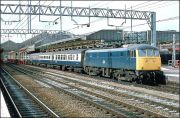 |
Moving to Crewe on the West Coast Main Line here is a picture of 85011 standing in the main up platform with a Liverpool to Euston train on 4 June 1986. I quite like photographing electric locos in stations as it is somewhat easier to get around the problem of intrusive catenary supports. |
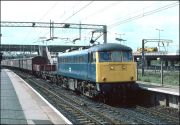 |
Moving further south to Bescot station, here is 85034 running through the platforms on 23 June 1986 with a freight from the Wolverhampton direction. The type of vans forming the train and the fact that there are 2 barriers indicate that this is 7G80 1425 Basford Hall SSM-Bescot Down NY - vans from Radway Green, conveying explosive materials for the MOD. Thanks to Mike Hollick for the train ID. |
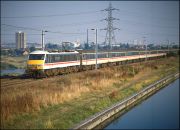 |
The final photograph in this location shows 90005 in original condition on 30 September 1989 with the 1G34 14.40 Euston to Wolverhampton. 645 |
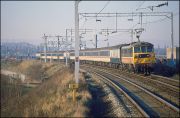 |
Another of my favourite shots for up trains from Wolverhampton was the platform at Tipton station. This one was taken on 23 November 1988 and shows 86414 on a Manchester to Birmingham service. I had started this day's photography at Water Orton, but it was quite foggy so I thought that a move to the other side of Birmingham might give a better chance of some sun. 645 |
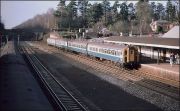 |
2005 will see the final runs of slam-door EMUs on the majority of the third rail electrified network. This predictably has seen much frantic activity by photographers keen to obtain some shots of these vintage units. As these were alien to me when I first started visiting Hampshire and Kent in 1987 I took many pictures of them. Around Basingstoke, the 4 VEPs were commonplace and formed most of the local services to Waterloo. Here is unit 7774 arriving on the up line at Winchfield station on 4 January 1988 whilst another of the same class is about to head down to Basingstoke. The Network Sout East colour scheme would soon be applied to these trains which gave a new colour to the scene around here. |
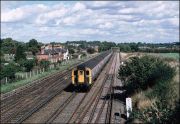 |
Worting junction lies a couple of miles to the west of Basingstoke and the footbridge there has long been a popular spot for railway photography. This picture taken on the afternoon of 14 Septemebr 1989 shows 4TC 8006 being propelled by one of the powerful 4REP units on a Waterloo to Southampton train. This type of working was so commonplace iat the time that it barely seemed worth exposing a frame on, but as usual, the passage of time has changed all that. |
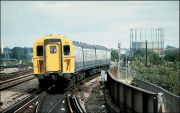 |
One of the anomalies on the former Western Region is the electrified line from Waterloo which runs to Reading. This gives the somewhat incongruous sight of electric units in the former Great Western station. This goes back to steam days when Southern Railway locomotives worked to Reading over the line via Ascot. There is a very steep gradient up to the bay platforms at the east end of the station which can just be seen at the rear of unit 7819 arriving on 24 August 1985. |
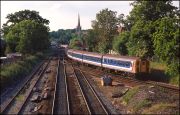 |
The footbridge by the tennis club at Wokingham was the location for this shot of 4VEPs 3484+3155 on 25 May 1990. I was on my home after a day photographing 33s (and EPBs) n the Sidcup Loop and as the sun hadn't shown any signs of disappearing by the evening, I dropped in here with the intention of photographing 6O60, the Theale to Northfleet cement empties. Just before the freight hauled by 33009+33029 appeared, this Reading to Waterloo service came along. |
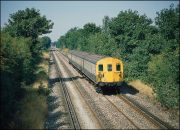 |
I spent quite a bit of time on the Sidcup loop in 1990 as there was a lot of freight, including regular class 33 workings with various Channel Tunnel aggregate and other trains. I couldn't resist photographing the units either, and here is 4EPB 5482 in corporate blue & grey approaching Sidcup with a Charing Cross to Dartford local. 645 |
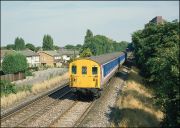 |
Looking the other way from the above photograph, this is unit 5602 in NSE livery heading towards London. There were several good footbridges on this stretch of line and I really enjoyed the photographic sessions I had along here. 645 |
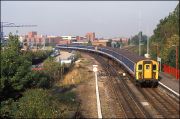 |
I had quite a good session on the station bridge at Staines on 27 September 1990, with photographs of a 47 on a freightliner and 2 class 33s on departmental workings in the bag by late morning. There were obviously regular units to photograph too, and here is 3466 leading another of the same type past the junction to Staines West and the newly erected and rather unsightly radio masts heading east towards Waterloo. |
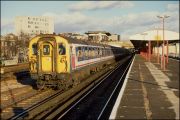 |
Moving back to the LSWR main line at Woking, here is unit 2302 leaving the station with a down Portsmouth service. The period between Christmas and New Year marked a low spot for NSE class 50s, with only a couple of locomotives being available. This meant that class 33s were called upon to haul many Exeter and Salisbury trains which accounts for my presence here on 27 December 1990. I took the opportunity for a number of unit photographs, some of which appear below. |
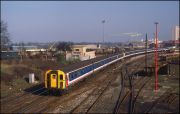 |
Staying on the bridge at Woking junction but looking over the Guildford road, here is a 12 car unit heading for Portsmouth and Southsea. 47326 is just visible on the LSWR with a train of empty oil tanks which are going to the Holybourne Carless terminal on the Alton line. |
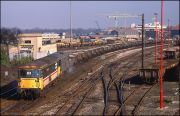 |
73119+73108 have just arrived at Woking from the east and are seen here shunting into the down yard. The loco in the plain grey livery, 73108, has just struck a spark from the live rail, hence the small puff of smoke visible by the rear bogie. |
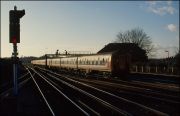 |
Just catching the last rays of winter afternoon light on 27 December 1990 at Woking is an up local train formed of 2 4 VEPs. One of the problems of photography at this time of year is the heavy shadow formed on the front of backlit subjects. I regarded this as a challenge and tried to produce a slightly impressionistic photograph rather than a pure record shot. |
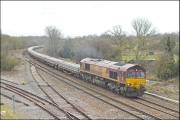 |
The line from Birmingham to Leamington Spa threw up a couple of relatively unusual moves on Thursday 6 March 2008. This first was this, 6V25, a Bescot to Eastleigh train of concrete sleepers. If I remember correctly, this service normally works south in the early hours of the morning but on this occasion ran through Hatton just after 12.30pm. The main reason for including this photograph is the exhaust being emitted by 66220. This was clearly a heavy train and the locomotive was working hard under clear signals as it began the descent of Hatton Bank. |
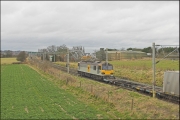 |
There is no conventional northbound shot available at Wootton Green, near Balsall Common, so I had to content myself with a picture of 92007 going away towards Birmingham. The train is 4M05, the 02.44 Felixstowe to Trafford Park intermodal, which was nearly 5 hours at this point. Purely from the enthusiasts' viewpoint, this late running issometimes advantageous because it does enable one to obtain photographs of workings which would otherwise not be possible. |
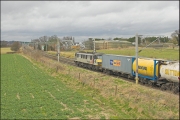 |
My final photograph from 8 March 2008 shows 90048 passing Wootton Green with 4M45, the 03.16 Felixstowe to Ditton freightliner. In common with everything else I photographed, this was running late, although at about 4 hours behind the booked time, not quite as badly delayed as some others I had seen. This working made a somewhat better going-away shot than that of 92007 as at least there were some colourful bits immediately behind the locomotive. Thanks go to Andy Williams and an anonymous source for much of the information received today. |
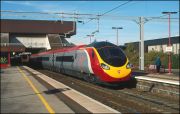 |
Virgin's Pendolinos have not been well received by railway enthusiasts. I don't think they are all that bad, and photograph quite well in decent light as witnessed by this example in the main up platform at Birmingham International station on 24 October 2003. In my opinion, there is not a world of difference between a well-designed multiple unit such as this, and an electric locomotive, matching coaches and DVT all in the same colour scheme. It is just the average British enthusiasts' traditional bigotry against anything other than a loco. |
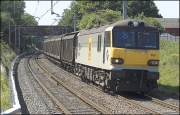 |
Here is 92009 about to pass Berkswell station with 6A42, the 15.15 Bescot - Wembley. As usual, this was a very long train, mostly consisting of ferrywagons but with a couple of 4 wheel ballast hoppers on the back. |
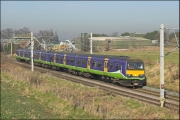 |
The line between Birmingham New Street and Coventry is a happy hunting ground for anyone wishing to photograph a variety of 25KV electric units. Here is a former Silverlink unit, 321417, passing Wootton Green on a New Street to Coventry local service during the morning of 12 February 2008. I quite like a session photographing units as they are amongst the most colourful trains on the network and it's good to record the ever-changing liveries. |
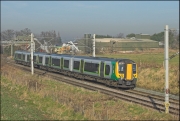 |
In contrast to the photograph above, this picture taken at Wootton Green on 12 February 2008 shows the more usual train for a local service to Coventry, a class 350 Desiro unit in the shape of 350129 . I travelled from Berkswell to New Street in one of these trains the day before this shot was taken and was quite impressed by the comfort, quietness and acceleration. Much better than the class 150s on my local line! |
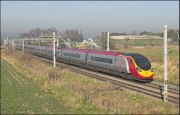 |
It is impossible to stand anywhere between Birmingham New Street and Coventry for long without seeing one of Virgin West Coast's class 390 Pendolino expresses. Here is 390051 heading east with a Euston-bound train on 12 February 2008. I find these trains quite stylish albeit somewhat monotonous after a few hours by the lineside. |